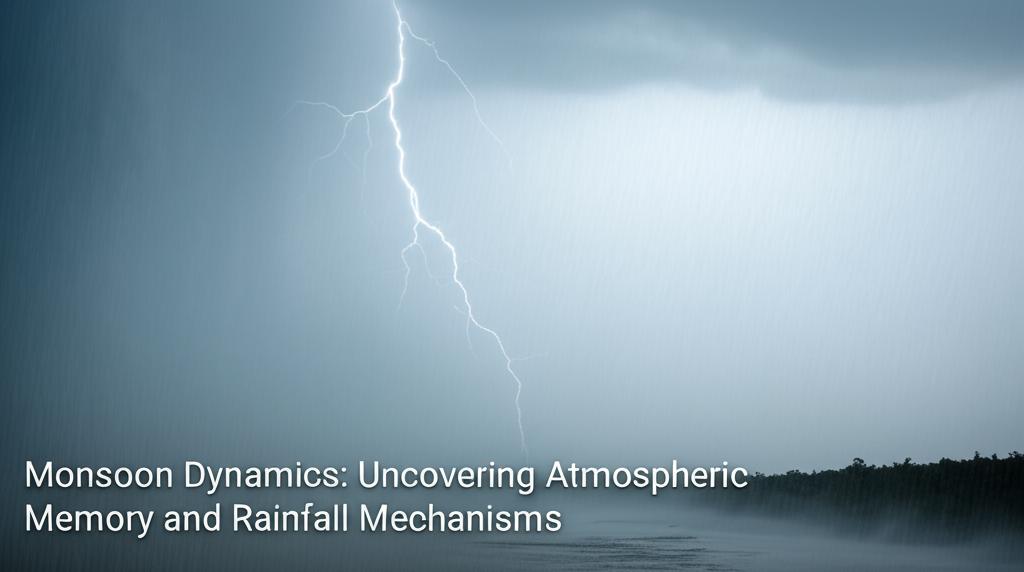Recent breakthroughs in understanding monsoon systems highlight the critical role of "atmospheric memory," primarily in the form of stored water vapor. This evolving understanding shifts away from the traditional view that monsoon onset and retreat are solely dictated by immediate changes in solar radiation.
Atmospheric Memory: The Key to Monsoon BehaviorA pivotal study published in May 2025 by the Potsdam Institute for Climate Impact Research (PIK) underscores that monsoon systems globally, including vital ones like the Indian southwest monsoon, possess a physical memory. This memory is attributed to the cumulative build-up of atmospheric moisture over time.
This stored moisture acts as a reservoir, influencing when monsoons "switch on" in the spring and "switch off" in the autumn. The research, combining observational data from various monsoon regions with atmospheric dynamic simulations, suggests that the atmosphere's current state is dependent on its seasonal history. This means that even as solar radiation fluctuates with the seasons, the atmospheric response isn't always immediate. Water vapor accumulates over days and weeks during spring, and this reservoir ultimately determines the onset of monsoon rainfall in early summer and sustains it even as solar influx diminishes in autumn.
This phenomenon, where a system's response lags behind an input and is shaped by its own history, is known as hysteresis. In the context of monsoons, it means that if it's already raining, it's likely to continue, and conversely, dry conditions make it more difficult for rainfall to begin.
Thresholds and Tipping PointsThe research identified a critical threshold for this atmospheric memory. When the atmospheric water vapor content exceeds approximately 35 kilograms per square meter, the monsoon system tends to "switch on." If it drops below this level, it "switches off." This abrupt, threshold-based response indicates a bistability in monsoon systems, allowing them to flip between two stable states – wet and dry.
Notably, these simulations showed that monsoons can flip between these states even without the traditionally assumed thermal inertia provided by oceans. The column of atmospheric moisture itself is key, sustaining rainfall for weeks and acting as the system's tipping point. The monsoon crosses this tipping point annually and then returns, a unique characteristic among climate tipping elements.
Mechanisms Driving Monsoon RainfallWhile the concept of atmospheric memory is a significant advancement, the broader understanding of monsoon rainfall mechanisms involves several interconnected factors:
- Moist Static Energy (MSE) Budget: This framework helps identify key processes limiting or promoting monsoon rainfall. For example, high surface albedo (like in the Sahara Desert) can prevent the net energetic input needed for deep moist convection, thus limiting the West African Monsoon. Conversely, orography (like the Tibetan Plateau shielding the Indian monsoon from dry air intrusion) can promote rainfall.
- Intertropical Convergence Zone (ITCZ) Shifts: Monsoons are also understood as local manifestations of energetically forced shifts in the ITCZ. However, adapting this framework to individual, zonally confined monsoons is complex and requires incorporating zonally asymmetric processes.
- Land Surface Interactions: Soil moisture plays a role in the persistence of rainfall anomalies. Increased soil moisture can enhance land surface evaporation, contributing to continued rainfall, particularly in the middle and later parts of the monsoon season. This suggests a "land memory" effect that can contribute to the self-sustaining nature of monsoon variability.
- Wind-Evaporation Feedback: In some regions, like northern Australia, intensified monsoonal circulation can enhance oceanic evaporation and downstream moisture transport, creating a positive feedback loop that sustains rainfall.
- Vegetation and CO2: Rising atmospheric CO2 levels influence the terrestrial hydrological cycle through both climate-radiative forcings (warming effects) and vegetation-physiological forcings (plant responses to CO2). Plant responses can modulate seasonal rainfall and water resources by affecting evapotranspiration rates and atmospheric circulation.
- Aerosols and Greenhouse Gases: Anthropogenic factors like greenhouse gas concentrations and aerosol emissions have profound consequences on monsoon behavior. The "wet get wetter" mechanism, driven by increased lower-tropospheric water vapor in a warming atmosphere, is a key concept. However, the dynamic effects of changing atmospheric circulation also play a crucial role.
The discovery of significant atmospheric memory in monsoon systems has profound implications. Disrupting this delicate balance, particularly the tipping points associated with moisture accumulation, could have severe consequences for the billions of people reliant on monsoon rainfall for agriculture and water security.
This new understanding opens avenues for potentially identifying monsoon tipping points using observational data and developing early warning systems. Continued research focusing on the interplay between atmospheric memory, large-scale circulation patterns, land-ocean-atmosphere interactions, and the impacts of climate change is crucial for improving monsoon predictions and safeguarding vulnerable populations. The dynamic interplay of these factors, including the role of westerlies and varying strengths of different monsoon systems (like the Indian Summer Monsoon and East Asian Summer Monsoon) in specific regions such as Central Asian high mountains, further highlights the complexity of monsoon dynamics. Understanding these regional interactions is vital for predicting extreme precipitation events and managing water resources under a changing climate.

